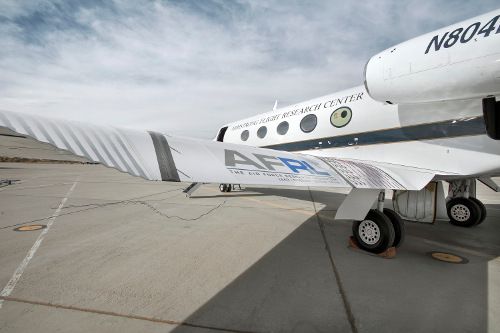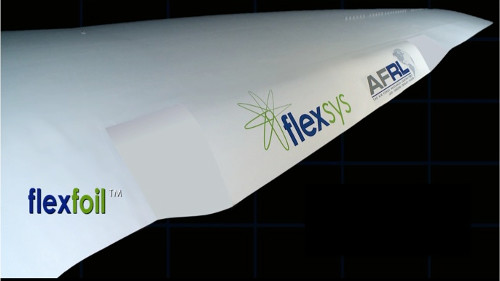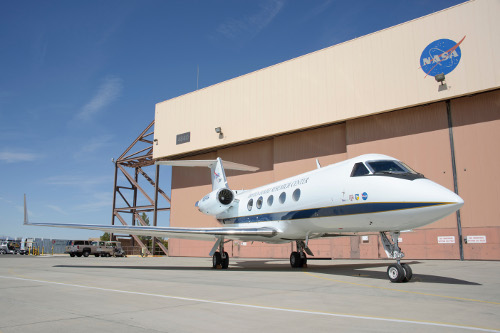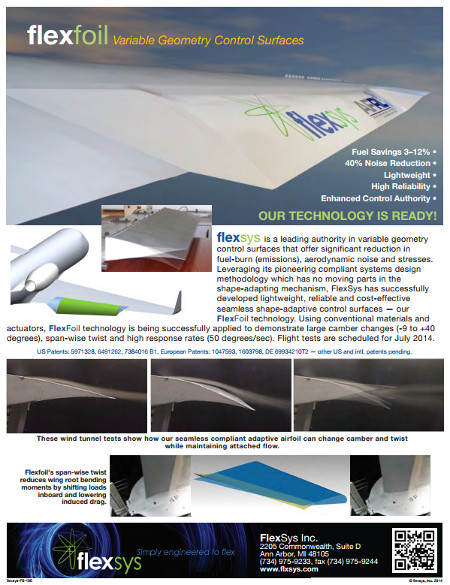 |
| December 09, 2014 | Volume 10 Issue 46 |
Designfax weekly eMagazine
Archives
Partners
Manufacturing Center
Product Spotlight
Modern Applications News
Metalworking Ideas For
Today's Job Shops
Tooling and Production
Strategies for large
metalworking plants
Wings:
NASA tests shape-changing aircraft flap for first time
NASA's green aviation project is one step closer to developing technology that could make future airliners quieter and more fuel efficient with the successful flight test of a wing surface that can change shape in flight.
This past summer, researchers replaced an airplane's conventional aluminum flaps with advanced, shape-changing assemblies that form seamless bendable and twistable surfaces. Flight testing will determine whether flexible trailing-edge wing flaps are a viable approach to improve aerodynamic efficiency and reduce noise generated during takeoffs and landings.

For taxi testing on Oct. 31, 2014, at NASA's Armstrong Flight Research Center at Edwards Air Force Base in California, the Adaptive Compliant Trailing Edge (ACTE) flap was extended to 20 degrees deflection. Flight results will validate whether the seamless design with its advanced lightweight materials can reduce wing structural weight, improve fuel economy and efficiency, and reduce environmental impacts. [Image Credit: NASA/Ken Ulbrich]
The Adaptive Compliant Trailing Edge (ACTE) project is a joint effort between NASA and the U.S. Air Force Research Laboratory (AFRL) using flaps designed and built by FlexSys, Inc., of Ann Arbor, MI. With AFRL funding through the Air Force's Small Business Innovative Research program, FlexSys developed a variable-geometry airfoil system called FlexFoil that can be retrofitted to existing airplane wings or integrated into brand new airframes. The ACTE project involves replacement of both of the G-III's conventional aluminum flaps with the advanced, shape-changing FlexFoil flaps that form continuous bendable surfaces. The flexible flaps are made of composite materials to a patented design from FlexSys.
FlexFoil's inventor, FlexSys founder and Chief Executive Officer Sridhar Kota, hopes testing with the modified Gulfstream III will confirm the design's flight worthiness and open doors to future applications and commercialization. ACTE is being flown at NASA's Armstrong Flight Research Center in Edwards, CA.
"This flight test is one of the NASA Environmentally Responsible Aviation (ERA) Project's eight large-scale integrated technology demonstrations to show design improvements in drag, weight, noise, emission, and fuel reductions," said Fay Collier, ERA project manager at NASA's Langley Research Center in Hampton, VA.

A FlexFoil prototype wing.
During the initial ACTE flight, the experimental control surfaces were locked at a specified setting. Different flap settings will be employed on subsequent flights to collect a variety of data demonstrating the capability of the flexible wings to withstand a real flight environment. The flaps have the potential to be retrofitted to existing airplane wings or integrated into new airframes. From the outside, the wing looks like a single solid structure, but one that can bend and deform with precise control.
Changing the shape of a modern aircraft's wing in flight has been an elusive goal. Unlike the earlier iterations, which suffered from complexities with the actuators and problems of heavyweight componentry, the FlexFoil control surface technology employs a new approach, called distributed compliance, to achieve practical variable geometry wings that are lightweight, reliable, and cost effective.

In retrofit applications, FlexSys says the technology can cut fuel consumption by 4 percent to 8 percent, and that number can grow to 12 percent or more in clean-sheet builds. Other benefits of the technology include significant noise reduction (up to 40 percent during landing) and lowered maintenance costs due to reduced wing loads.
Kota, a mechanical engineering professor at the University of Michigan, pioneered the method of Distributed Compliance -- a form of structural load sharing by exploiting elasticity to design monolithic compliant structures, which are also called joint-less mechanisms. Starting in 2001, he focused the efforts of his newly formed FlexSys company toward practical applications of his patented technology, and with funding from AFRL proved the viability of his designs through various tests to confirm structural integrity and enhanced aero performance.
FlexSys' design demonstrates wing morphing at practical scales. For instance, as a complete replacement of conventional trailing-edge flaps on a "generic" Gulfstream Business Jet, FlexFoil seamless control surfaces each extend 14 ft span-wise along with 2-ft-long seamless transition sections on both ends, offering a camber change from -9 deg to 40 deg as well as span-wise twist at high rates (up to 50 deg/sec). The FlexFoil control surface is strong and stiff enough to support well over 10,000 lb of air loads.
Using aerospace-grade materials and actuators in its design, FlexFoil's variable geometry design greatly exceeds the life cycles required of commercial aircraft flaps, and it can be applied to other control surfaces such as leading edge, engine inlets, and vertical and horizontal stabilizers. It also has the potential to revolutionize helicopter rotor design. FlexSys has already produced prototypes of variable-geometry leading and trailing edges for helicopter rotor blades for potential increases in forward speed, payload, and noise reduction.

"We have progressed from an innovative idea and matured the concept through multiple designs and wind tunnel tests, to a final demonstration that should prove to the aerospace industry that this technology is ready to dramatically improve aircraft efficiency," said AFRL Program Manager Pete Flick, from Wright-Patterson Air Force Base, OH.
ACTE technology is expected to have far-reaching effects on future aviation. Advanced lightweight materials will reduce wing structural weight and give engineers the ability to aerodynamically tailor the wings to promote improved fuel economy and more efficient operations, while reducing environmental impacts.
"The first flight went as planned -- we validated many key elements of the experimental trailing edges," said Thomas Rigney, ACTE Project Manager at Armstrong. "We expect this technology to make future aircraft lighter, more efficient, and quieter. It also has the potential to save hundreds of millions of dollars annually in fuel costs."
Source: NASA, FlexSys
Published December 2014
Rate this article
View our terms of use and privacy policy
